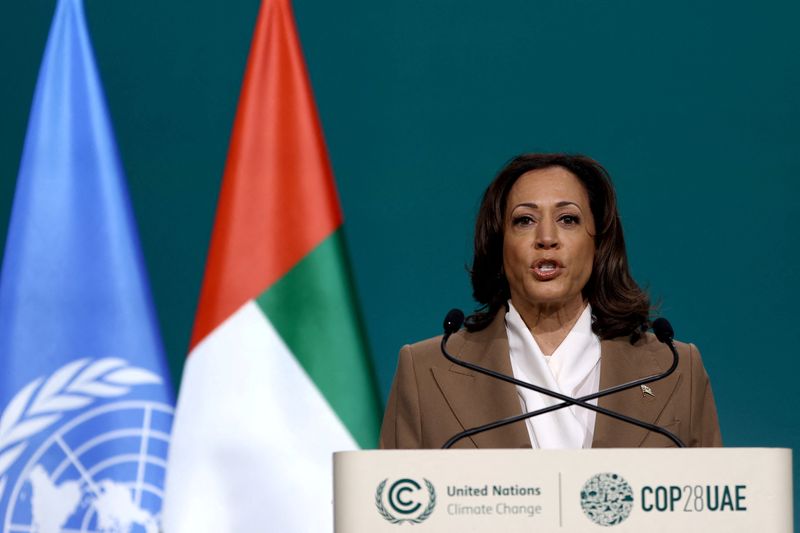Commodities
COP28: US touts climate leadership as oil and gas output hits record


© Reuters. U.S. Vice President Kamala Harris speaks during the United Nations Climate Change Conference COP28, in Dubai, United Arab Emirates, December 2, 2023. REUTERS/Amr Alfiky
2/3
By Richard Valdmanis, Sarah McFarlane and Simon Jessop
DUBAI (Reuters) -U.S. Vice President Kamala Harris sought to claim the mantle of global climate leadership for the United States on Saturday in a speech to the COP28 summit, listing a slew of initiatives to cut emissions and harness renewable energy in the world’s largest oil and gas producer.
The address came on the second day of back-to-back speeches by world leaders at the conference in Dubai, where nearly 200 nations are hashing out an international approach to tackling global warming and debating whether fossil fuels should maintain a role in a future energy economy.
“Two years ago, President Joe Biden stood on stage at COP26 and made a declaration of ambition: The United States of America will once again be a global leader in the fight against the climate crisis,” Harris said. “Since then, the United States has turned ambition into action.”
She listed the more than $400 billion in subsidies provided by the 2022 Inflation Reduction Act, Biden’s signature climate law, which has triggered a flood of clean energy investment. She also announced a new $3 billion pledge to the Green Climate Fund, which helps developing countries combat global warming.
On the sidelines of the conference, the United States also unveiled new measures to curb emissions of the powerful greenhouse gas methane from oil and gas operations.
“Today, we are demonstrating through action how the world can and must meet this crisis,” Harris said.
The United States, the world’s second largest greenhouse gas emitter behind China, has seen a surge in investment for clean energy projects ranging from solar farms to wind turbines and electric vehicle battery factories in recent years.
But it has also grown into the globe’s biggest producer of oil and gas – the main source of climate emissions – following a technology-driven drilling boom in the sprawling Permian Basin in Texas and New Mexico.
That awkward coincidence underscores one of COP28’s most contentious questions: Can the world’s response to climate change involve continuing use of fossil fuels?
Among the decisions nations must make will be whether to agree, for the first time, to gradually “phase out” fossil fuels and replace them with renewable energy sources.
Harris told the conference that the United States supports phasing out of “unabated coal” use, but she did not mention other fossil fuels.
The COP28 host, OPEC-member United Arab Emirates, hopes to sell a vision of a low-carbon future that includes, not shuns, fossil fuels – mainly through the use of technologies that can capture carbon dioxide to keep it from the atmosphere, or by making oil and gas operations cleaner.
FOSSIL FIRMS VOW TO DECARBONISE OPERATIONS
The UAE on Saturday announced a commitment by 50 energy firms representing around 40% of global oil output to cut methane emissions from their operations to near zero by 2030, and eliminate all greenhouse emissions from their operations by 2050.
U.S. oil major Exxon Mobil (NYSE:) and Saudi Arabia’s Aramco (TADAWUL:) were among the companies that joined the initiative, although both already had these targets in place via their membership of the Oil and Gas Climate Initiative (OGCI).
Climate campaigners were skeptical of the pledges.
“Net zero commitments that haven’t been backed up by plans and aren’t anchored in government regulation are not worth celebrating. We need to be moving from pledges to regulation,” said Catherine Abreu, founder of the non-profit Destination Zero.
“We’ve seen a long history of oil companies making climate pledges that don’t result in real action.”
John Podesta, a senior energy advisor to U.S. President Joe Biden, told Reuters on Saturday that record U.S. production was helping to keep consumer prices steady after Russia’s invasion of Ukraine.
He added that the United States has tried to reduce drilling on public lands and waters, but has been pushed back by courts, and that U.S. policy was now mainly focused on limiting demand for petroleum.
“We’re in a context in which we need to reduce production of fossil fuels and … we need to be on a path of lower consumption. Our policies are aimed at doing that,” he said.
The conference on Saturday also featured a slew of international deals to make energy systems more climate-friendly around the world, including by boosting renewable sources and nuclear energy, and by choking off financing for coal.
Elsewhere, the United States was among a group of 56 countries to commit to steps to accelerate decarbonisation by 2030 across sectors including power, road transport, steel, hydrogen and agriculture.
___
For daily comprehensive coverage on COP28 in your inbox, sign up for the Reuters Sustainable Switch (NYSE:) newsletter here.
Commodities
Oil prices rise; U.S. crude inventories plunge, Russia-Ukraine truce eyed
Commodities
India’s Reliance to stop buying Venezuelan oil over US tariffs, sources say
Commodities
Oil prices climb on Venezuela supply worries

 Forex3 years ago
Forex3 years agoForex Today: the dollar is gaining strength amid gloomy sentiment at the start of the Fed’s week

 Forex3 years ago
Forex3 years agoUnbiased review of Pocket Option broker

 Forex3 years ago
Forex3 years agoDollar to pound sterling exchange rate today: Pound plummeted to its lowest since 1985

 Forex3 years ago
Forex3 years agoHow is the Australian dollar doing today?

 Cryptocurrency3 years ago
Cryptocurrency3 years agoWhat happened in the crypto market – current events today

 World3 years ago
World3 years agoWhy are modern video games an art form?

 Commodities3 years ago
Commodities3 years agoCopper continues to fall in price on expectations of lower demand in China

 Economy3 years ago
Economy3 years agoCrude oil tankers double in price due to EU anti-Russian sanctions























